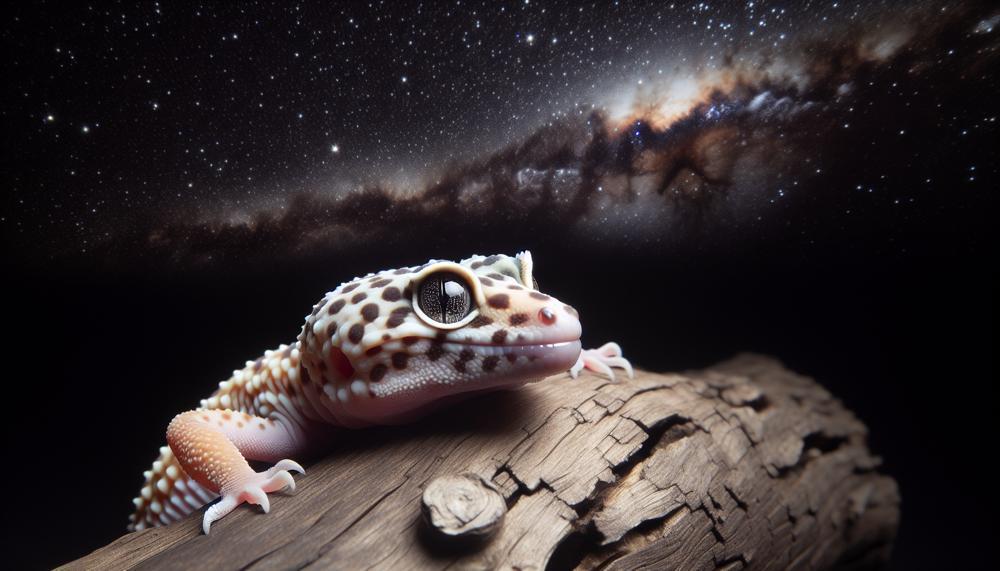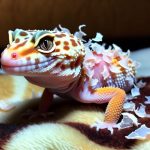Attention all reptile enthusiasts. Have you ever caught your leopard gecko gazing up at the stars? This peculiar behavior, known as “stargazing,” is actually quite common among these creatures. But what does it mean and why do they do it?
Stargazing is when a leopard gecko tilts its head upwards. It stares at the ceiling or sky for extended periods of time. It may seem like a harmless quirk. However, it can be caused by various factors such as illness, stress, or even just curiosity. In some cases, it could also be a sign of a serious health issue that requires immediate attention.
So, if you’ve noticed your gecko stargazing, don’t brush it off as a quirky habit. As responsible pet owners, it’s important to understand our pets’ behaviors and know when something may be amiss. In this blog post, we’ll explore the possible reasons behind this behavior. We’ll also provide tips on how to address it.
Let’s unravel the mystery of stargazing. We want to ensure our beloved leopard geckos are happy and healthy.
Keep reading to discover the fascinating reasons behind this behavior. Learn how you can help your little buddy thrive.
Contents
- 1 How Long Do Leopard Geckos With Enigma Syndrome Live For?
- 2 How Do I Know If My Leopard Gecko Has Enigma?
- 3 What Causes Enigma in Leopard Gecko?
- 4 What Do I Do If My Leopard Gecko Has Mbd?
- 5 Enigma Syndrome in Leopard Geckos | Everything You Need to Know
- 6 Symptoms of Enigma Syndrome in Leopard Geckos
- 7 Leopard Gecko Stargazing
- 8 Leopard Gecko Death Roll
- 9 Is Enigma Syndrome Fatal
- 10 Conclusion
How Long Do Leopard Geckos With Enigma Syndrome Live For?
Enigma Syndrome is a hereditary condition that affects leopard geckos with the enigma morph and their offspring. This neurological disorder can manifest in various symptoms, such as head tilting, difficulty catching prey, seizures, and death rolls. Unfortunately, ES does not have a known cure; however, proper care and treatment can help manage its effects.
The lifespan of leopard geckos can be significantly impacted by Enigma Syndrome. The severity of the disorder can range from mild to severe, with more severe cases leading to premature death. While a healthy leopard gecko can live for 10-15 years on average, those with ES may have a much shorter lifespan.
ES also has a profound impact on the overall health and well-being of the gecko, leaving them more vulnerable to other health problems. For instance, this disorder can weaken the immune system and increase the risk of developing metabolic bone disease (MBD). MBD often occurs in conjunction with ES due to the gecko’s decreased ability to absorb vitamin D3.
Moreover, Enigma Syndrome can result in several complications that can further affect the gecko’s lifespan. These include difficulty hunting for food, which can lead to malnutrition and organ failure over time. Additionally, seizures and death rolls caused by ES add strain on the gecko’s body and may ultimately result in an early demise.
How Do I Know If My Leopard Gecko Has Enigma?
If your leopard gecko has Enigma Syndrome, the symptoms can range from mild to severe and may vary depending on its genetic makeup. Some common signs to watch out for include tilting of the head, difficulty catching prey, seizures, and death rolls.
If you notice any of these symptoms in your leopard gecko, it is crucial to seek veterinary care immediately.
| Signs | Severity | Description |
| Tilting of the head | Mild to severe | Leopard geckos with Enigma Syndrome may exhibit a noticeable head tilt, making it challenging for them to move around and catch prey. |
| Difficulty catching prey | Mild to severe | The condition can cause coordination and vision issues, making it difficult for leopard geckos to catch their food. |
| Seizures | Mild to severe | In severe cases, leopard geckos with Enigma Syndrome may experience frequent seizures, which can be life-threatening if left untreated. |
| Death rolls | Severe | In rare cases, the condition may cause uncontrollable rolling movements that can lead to injury and even death. |
If you suspect that your leopard gecko has Enigma Syndrome, it is essential to seek veterinary care immediately. A reptile veterinarian will be able to diagnose the condition and provide proper treatment and management options.
In addition to regular check-ups with a reptile veterinarian, providing proper care and management is crucial for improving the quality of life for a leopard gecko with Enigma Syndrome.
This includes creating an ideal environment with the appropriate enclosure size, safe substrate, temperature regulation, hiding spots, and enrichment opportunities.
Adjustments may also be necessary for feeding methods and handling to accommodate any difficulties caused by Enigma Syndrome.
What Causes Enigma in Leopard Gecko?
Enigma Syndrome, a genetic disorder, is the primary cause of stargazing in leopard geckos. However, reckless breeding methods and inadequate care can also play a role in the development of this condition.
Below, we will delve into the various factors that can contribute to Enigma Syndrome in leopard geckos.
| Factors Leading to Enigma Syndrome in Leopard Geckos | Description |
| Faulty Genetics | The presence of a dominant gene is the main cause of Enigma Syndrome. This gene can be inherited from either parent, resulting in affected leopard geckos being heterozygous or homozygous dominant for the gene. |
| Irresponsible Breeding Practices | Enigma morph leopard geckos are most commonly associated with Enigma Syndrome, but it can also occur in other morphs involving the enigma gene. To prevent the spread of this disorder, it is crucial to follow responsible breeding practices. |
| Improper Care and Management | While there is no known cure for Enigma Syndrome, proper care and management can help affected leopard geckos lead a relatively healthy life. Owners must be attentive to their gecko’s specific needs and provide appropriate environmental accommodations to minimize stress and ensure their well-being. |
| Limited Treatment Options | Unfortunately, there is currently no cure for Enigma Syndrome in leopard geckos. However, treatment options such as providing sufficient calcium and Vitamin D3 can improve overall health. It’s important to consult with a veterinarian who specializes in reptiles for proper diagnosis and treatment. |
| Unique Challenges in Breeding | Breeding Enigma Leopard Geckos presents unique challenges and requires responsible breeding practices to benefit both individuals and the wider community. It is essential to carefully select breeding pairs and monitor for any signs of Enigma Syndrome in offspring. |
Enigma Syndrome is a complex condition that can greatly impact the lives of leopard geckos. Not only does it affect their physical health, but it also poses challenges in breeding and requires careful consideration when choosing breeding pairs.
Furthermore, there is currently no known cure for this disorder, highlighting the importance of responsible breeding practices and proper care and management for affected geckos.
What Do I Do If My Leopard Gecko Has Mbd?
If you suspect that your leopard gecko may have MBD (Metabolic Bone Disease), it is crucial to take immediate action to prevent further deterioration of their health. MBD is a severe condition that affects the bones and muscles of reptiles, causing weakness, deformities, and even death if left untreated. Here are some steps you can take to help your leopard gecko if they are suffering from MBD.
Provide appropriate calcium and vitamin D supplementation: Calcium and vitamin D are essential for maintaining strong and healthy bones in leopard geckos. A deficiency in these nutrients can lead to MBD. Be sure to dust their food with a calcium and vitamin D supplement, and also provide a calcium dish in their enclosure.
- Ensure access to sufficient UVB lighting: UVB lighting is crucial for leopard geckos as it aids in the production of vitamin D and absorption of calcium. Without proper exposure to UVB light, they are at risk for developing MBD. It is essential to provide a UVB light source that covers at least two-thirds of their enclosure.
- Maintain the correct temperature: Leopard geckos require a warm basking spot and cooler areas in their enclosure to regulate their body temperature. Inadequate temperatures can also contribute to MBD. Use a thermometer to monitor the temperature and make necessary adjustments.
- Offer a balanced and nutritious diet: A well-balanced diet is crucial for preventing and treating MBD in leopard geckos. Provide a variety of feeder insects such as crickets, mealworms, and waxworms, as well as occasional treats like fruits and vegetables. Avoid overfeeding or obesity, as this can put added pressure on their bones.
- Consult with a reptile veterinarian: If your leopard gecko exhibits severe symptoms of MBD, it is essential to seek professional help from a reptile veterinarian. They can provide appropriate treatment, such as calcium injections or oral supplements, and monitor their progress through regular checkups.
Enigma Syndrome in Leopard Geckos | Everything You Need to Know
Enigma Syndrome (ES) is a hereditary neurological disorder that affects leopard geckos, particularly those with the enigma morph and their crosses. This condition causes a range of symptoms, such as head tilting, difficulty catching prey, seizures, and even death rolls. One of the most noticeable behaviors associated with ES is stargazing. This involves the gecko tilting its head upwards towards the sky and gazing for extended periods.
The root cause of this behavior stems from the neurological complications caused by ES, which can impact the gecko’s sense of balance and coordination. As a result, they may struggle to move normally and appear disoriented or lacking coordination. Stargazing is a coping mechanism for this disorientation, as the gecko tries to orient itself by focusing on a fixed point.
Apart from stargazing, other behaviors that may be affected by ES include feeding, hiding, and general movement. Depending on the severity of the syndrome, these activities may be more challenging or impossible for affected geckos to perform. Hence, it is crucial for owners to be aware of these potential issues and provide suitable care and support for their gecko.
Proper care for leopard geckos with ES involves providing appropriate enclosures, substrates, temperature regulation, hides/enrichment, feeding methods, handling techniques, and regular check-ups with a veterinarian who specializes in reptiles. Such measures will help minimize stress and ensure the well-being of affected geckos. Owners must also pay close attention to their gecko’s specific needs and make necessary adjustments to help them live a relatively healthy life.
Furthermore, it is essential to note that ES can manifest itself differently in each gecko. Thus, it is crucial to monitor your pet closely and adapt their care accordingly.
Symptoms of Enigma Syndrome in Leopard Geckos
Leopard geckos are fascinating creatures, but they can face health challenges like Enigma Syndrome, which can be fatal. It is caused by genetic issues in the enigma morph or its crosses and can have a wide range of symptoms, from mild to severe.
Here are some common warning signs to look out for:
| Head Tilting | One of the most noticeable symptoms of Enigma Syndrome is head tilting. This occurs when the gecko’s head remains tilted to one side, making it difficult for them to move and navigate their environment. | Example: Affected geckos may have trouble targeting their prey due to their tilted head, leading to difficulty catching food. |
| Difficulty Catching Prey | Enigma Syndrome can also cause issues with hunting and catching prey. This can be a result of the head tilting, but other neurological complications can also affect the gecko’s coordination and motor skills. | Example: Affected geckos may struggle to catch and eat live insects, leading to weight loss and malnourishment if not properly managed. |
| Seizures | Sometimes, leopard geckos with Enigma Syndrome may experience seizures. These can range from mild twitches to full-blown convulsions and can be distressing for both the gecko and its owner. | Example: Seizures can also lead to injuries if the gecko falls or thrashes around in its enclosure. |
| Death Rolls | In severe cases, leopard geckos with Enigma Syndrome may exhibit a behavior known as death rolling. This is when the gecko flips and twists its body uncontrollably, often resulting in injury or death. | Example: Death rolls are a severe symptom and may require immediate intervention from a reptile veterinarian. |
If you notice any of these warning signs in your leopard gecko, it is crucial to seek veterinary care as soon as possible. A reptile veterinarian can provide a proper diagnosis and help create a treatment plan to manage the symptoms and improve your gecko’s quality of life.
It is also essential to understand the genetics of your leopard gecko. Enigma Syndrome can occur in both heterozygous and homozygous dominant geckos, so it is crucial to understand the potential risks when breeding enigma morphs.
In addition to proper veterinary care, creating a suitable environment for your leopard gecko can also help manage Enigma Syndrome symptoms.
Leopard Gecko Stargazing
Leopard geckos may exhibit signs of stargazing, such as constantly tilting their head upwards, seeming disoriented, or appearing lethargic. These behaviors can be indicative of a variety of underlying causes, including nutritional deficiencies, injuries or illnesses, environmental factors, and even genetic conditions. To address this behavior in leopard geckos, it is important to provide proper care and attention to their diet, environment, and genetics.
One of the most common reasons for stargazing in leopard geckos is a lack of essential nutrients in their diet. These reptiles require a balanced and varied diet that includes calcium and vitamin D3 to maintain healthy bones and prevent stargazing behavior. Injuries or illnesses can also lead to stargazing, as they can cause physical impairments that affect the gecko’s ability to move and orient itself properly.

Environmental factors such as inadequate lighting or temperature fluctuations can also contribute to stargazing in leopard geckos. These reptiles require specific levels of heat and light to thrive, so it is important to ensure their habitat is set up correctly. Additionally, genetic conditions such as encephalopathy (brain disorder) or hydrocephalus (abnormal accumulation of fluid in the brain) can also cause stargazing behavior in leopard geckos.
To prevent or address stargazing in leopard geckos, it is crucial to provide them with a suitable habitat and a nutritious diet. Additionally, regular check-ups with a veterinarian can help identify any underlying health issues that may be causing the behavior.
Leopard Gecko Death Roll
The Leopard Gecko Death Roll is a natural response displayed by captive leopard geckos when they are under stress or feel threatened. This behavior involves the gecko rolling onto its back and thrashing its body in a circular motion. It is a defense mechanism that serves to protect them from predators in their natural habitat. However, it can also be triggered by stress or improper handling in captivity. As responsible owners, it is crucial to comprehend and respect this behavior. By providing a stress-free environment for our geckos, we can prevent this behavior from occurring.
Although the Leopard Gecko Death Roll is a common aspect of their behavior, it can be unsettling for new owners. Imagine walking into your room and seeing your beloved pet rolling around on its back, seemingly in distress. It can be alarming, but it is important to remember that this behavior is a natural response for them. In the wild, it serves as an effective way to fend off predators. In captivity, it can also be an indication of stress or discomfort.
To prevent the Leopard Gecko Death Roll from occurring, it is essential to create a stress-free environment for your pet. This includes providing proper housing, temperature, and humidity levels, as well as handling them with care and gentleness. Avoid sudden movements or loud noises that can startle them and trigger this behavior.
Is Enigma Syndrome Fatal
Unfortunately, the answer is yes, especially for those with the Enigma morph and their crosses. This genetic disorder affects the neurological system of leopard geckos, producing a range of symptoms from mild to severe. While there is currently no cure for ES, there are steps that can be taken to help affected geckos live relatively healthy lives.
The symptoms of Enigma Syndrome can be alarming and distressing for both the gecko and its owner. These include head tilting, difficulty catching prey, seizures, and even death rolls. However, it’s important to stay informed and up-to-date on research and guidance surrounding this condition. Diagnosis can be made by observing these symptoms and consulting with a reptile-specializing veterinarian.
Creating an ideal environment with proper care is crucial for the well-being of leopard geckos with Enigma Syndrome. This includes providing appropriate environmental accommodations to minimize stress and ensure their overall health. Additionally, owners must pay close attention to their gecko’s individual needs and make necessary adjustments to their care plan.
Breeding Enigma Leopard Geckos can present challenges due to the faulty genetics that often cause ES. As responsible breeders, it is crucial to stay educated and informed about this condition in order to prevent passing it on to future generations.
Also Read: How Often Do Leopard Geckos Shed?
Conclusion
In conclusion, while stargazing may seem like a harmless behavior in leopard geckos, it can actually be a sign of Enigma Syndrome, a hereditary condition that can greatly impact their health and lifespan. As responsible owners, it is important to understand the causes of this disorder and how to properly address it. By providing proper care and seeking veterinary assistance when needed, we can ensure our beloved leopard geckos with Enigma Syndrome live happy and fulfilling lives.
It is crucial to prioritize responsible breeding practices and take action if we suspect our gecko may be suffering from MBD or other health issues. Let’s continue to educate ourselves on the behaviors of our reptile companions and provide them with the utmost care they deserve.






